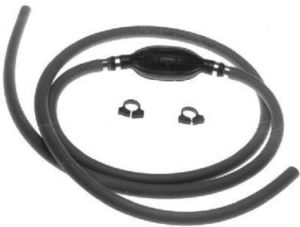My Dad’s First Experience in Importing from China
A few months back, my dad was looking to buy a relatively expensive inflatable boat (around $20,000 in Canada). Rather than pay the local retail prices here in Vancouver, he decided to get his friend to help him import one from China (his friend imported smaller inflatable boats on a regular basis).
He ended up paying around $7000 as a landed cost, and he was over the moon about the great deal he got.
Then a few days ago we're chatting, and he tells me about the crappy Chinese factory he bought his inflatable boat off of. He had gone to start the engine on his inflatable boat only to find the fuel line was totally corroded.
It turns out the Chinese factory had used a water line for the fuel line. The water line couldn't stand up to the corrosiveness of gasoline and corroded away within weeks. Thankfully, nothing too negative came out of things (he simply replaced the fuel line for around $5), but it could have been quite dangerous.

As we were chatting, my dad explained to me that he practically had to beg the factory to sell him the boat with the fuel tank and fuel line in it, as they normally only sell them without. In fact, his friend (whom he was coordinating this all through) even warned him beforehand that he had heard fuel line horror stories from numerous inflatable boat manufacturers in China.
Now my dad can be forgiven for many of the critical mistakes he made as a recreational importer. But let's examine a couple of the mistakes he made:
- He was informed that a service he had requested was rarely performed by this factory. Subsequently, it was probable that they might be guilty of oversight like using a water line instead of a fuel line.
- He was aware that problems relating to fuel hoses were commonplace.
- He never looked into whether fuel tanks and lines were regulated by a government agency.
He could have easily taken a couple of steps to avoid what could have been a disastrous outcome, such as the following:
- On the PO, he should have clearly described the required specifications of the fuel hose. On a relatively complex product like an inflatable boat, you can't describe in detail every functional part of it, but you can describe the most important areas, especially those that have been known to have issues in the past.
- He should have arranged either a pre-shipment inspection that specifically requested the inspector to examine the fuel hoses or at the very least inspected it once it arrived.
- He should have researched the regulations for fuel tanks/lines coming into Canada. His shipment was not inspected by customs, but if it was and there were regulatory requirements for fuel tanks/lines, his first time importing experience could have been even more sour.
Again, my dad can be forgiven for these simple mistakes, but for the professional importer, these are critical duties of our profession.




Hi Dave,
Liked your blog on importing an inflatable boat from China. I’m looking into doing the same (I live in Ontario) and wondered if you had any specific tips on how to avoid surprise costs and issues. I imported an ebike last year and was caught off guard by high freight forwarding costs. Any input is appreciated. Thanks.
Expect higher freight costs than last time :)
Hello David,
could you please help me locate a reliable freight forwarder to central Africa.
I am in Cameroun and I am looking to purchase goods in Shanghai and Guangzhou for my small restaurant.
thank you
Hi Rose,
I have no experience in Cameroon but I would checkout fleet.com who we just did an interview with :)